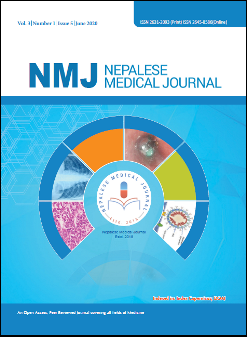Fetomaternal Outcome in Second Stage Caesarean Section
DOI:
https://doi.org/10.3126/nmj.v3i1.28923Keywords:
Caesarian section, Labour, Complication, Maternal, Neonatal, Second stage of laborAbstract
Introduction: Second stage caesarean section is usually associated with the deeply engaged head, less liquor, and thinned out the lower uterine segment. This can lead to a high risk of maternal morbidities like an extension of the lower uterine segment incision, uterine atony, and injury to urinary bladder as well as neonatal morbidities such as birth asphyxia, NICU admission, and meconium aspiration syndrome. This study aims to observe the maternal and neonatal outcomes of caesarean delivery performed in the second stage of labor.
Materials and Methods: This was a retrospective study of the fetomaternal outcome of all women with singleton, a cephalic fetus at term delivered by caesarean section in the second stage of labor over one year at Tribhuwan University Teaching Hospital.
Results: During this study period, there were 4653 deliveries. A total of 2274(48.88%) were born by caesarean section, out of which 1739 (76.5%) were elective and 535(23.5%) were emergency. Among emergency LSCS 36(6.72%) were performed in the second stage of labor. Most of the indications were nondescent of head 34(93.5%) followed by intraoperative maternal complications (hematuria; n=14; 38.88%). Postoperative maternal who had complications were prolong catheterization: 14(38.88%), postoperative fever : 10 (27.77%), prolong hospitalization: 5(13.88%). In perinatal complications meconium stain liquor : 10(27.77%), NNU admissions : 5(13.88%), Apgar score <5 at 5 min : 5 (13.55%), NICU admission : 2(5.54%), fresh stillbirth : 1(2.77%) were observed.
Conclusions: Caesarean sections done in the second stage of labor are associated with severe maternal and neonatal complications.
Downloads
Downloads
Published
How to Cite
Issue
Section
License
This license enables reusers to distribute, remix, adapt, and build upon the material in any medium or format, so long as attribution is given to the creator. The license allows for commercial use.
Copyright on any article published by Nepalese Medical Journal is retained by the author(s).
Authors grant Nepalese Medical Journal a license to publish the article and identify itself as the original publisher.
Authors also grant any third party the right to use the article freely as long as its integrity is maintained and its original authors, citation details and publisher are identified.




